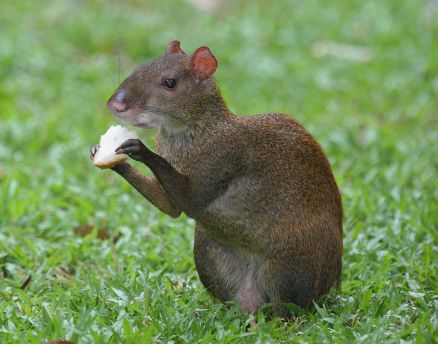There are many dynamic relationships in the rainforests of the world. Which is expected as they are home to up to 40 percent of known plant and animal species. Within the forest there are a widely variety of symbiotic relationships, which means there are interactions between two species. For some species the relationship is beneficial for both parties, this is call mutualism. For example the Brazil nut trees (Bertholletia excelsa) produces a nut that is an only be cracked by a few species, one of which is various agouti (Dasyprocta sp.) which is a small rat like animal. The tree benefits as it’s seeds are dispersed and the agouti receives a free meal.

| Description |
English: A Central American Agouti (Dasyprocta punctata) in Panama experimenting with a western diet.
|
| Source | BirdPhotos.com |
| Author | Tomfriedel |
In some cases one species is unaffected and the other benefits, this is commensalism. A example of this would be a frog sheltering itself from a storm event under the leaves of a plant. The plant is un effected but the frog benefits. Lastly, parasitism is when one species is harmed and the other benefits. Bot flies are a common tropical parasite that lay their eggs on a mammal host. The eggs then hatch and the larva develop in the skin of the host animal.

A frog in the rain in Belize. Image by Lauren Schramm
Competition is a symbiotic relationship in while two species use the same resources. Because it requires an energy investment both species are harmed, but the harm may be unequal. Many rainforest plants are animal pollinated or their seeds are dispersed by animals. Resource partitioning occurs when a resource is divided among species in some way like time or place. One way plants reduce their competition against each other is by targeting different animal groups. For example flowers pollinated by bats are often white making them easier to see at night, while flower pollinated by other animals are red, orange, and yellow. Bat pollinated flowers also contain a musky smells, while flower pollinated by moths, bees, and other insects have a strong fragrance. Plants also reduce competition by flowering and fruiting at different times. This is one reason there are always flowers and fruits available in the rainforest at any given time.
Many organisms in the rainforest have coloration that signals to others. In particular frogs have been well documented using coloration. Poison-dart frogs use aposematic coloration. This occurs when an organism is colored in a way that tells other animals to leave it alone. Poison dart frogs contain toxins. Some organism use aposematic coloration as copy cats to trick predators into thinking that they are poisonous. Aposematic coloration involves bright colors. Other frogs use cryptic coloration. This is a coloration that helps an organism blend into its environment. For example the pied warty frog looks like bird poop.
In the rainforest deep shade prevent understory plant growth, as most trees are 100-115 feet tall. This forest structure is often called a climax community, as the forest will remain unchanged structurally unless there is a large scale disturbance like a natural disaster or fire. Trees also do not branch out until the top of the canopy. Because of this the trees have to adapted to prevent failing. This is one reason why some trees have buttressed roots. Trees also have buttress roots because of the lack of available nutrients. Rainforest soils have not been reset by glaciations like that have in most other places. This means that the soils are heavily weathered and lack nutrients, like phosphorus that are needed for plant growth. Most of the nutrients a plant reactive come from decomposing organic matter on the forest floor. The more space the roots take up on the floor the most nutrients can be absorbed. This is why surface roots are also common.

Trees with buttress trunks in the Belizean rainforest. Image by Lauren Schramm.
Epiphytes, plants that live on other plants, have dealt with limited light by living on other trees, often in the canopy. Hemiepiphytes have developed a unique way of reducing completion for light. They can begin their lifecycle either on the ground or in the canopy the vine then either grows upward or downward, and wraps its host tree. Over time the vine will kill the host tree, thus allowing for more available light. Once it reaches the forest floor it becomes a rooted plant. The vine is able to gain nutrients from the host plants and from the air. Other trees are able to deal with limited light by having large leaves.

Epiphyte on the center tree. Image by Lauren Schramm

Leave a comment